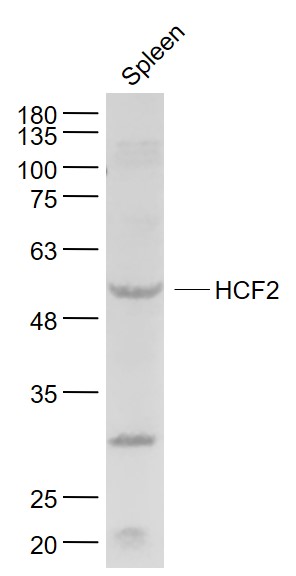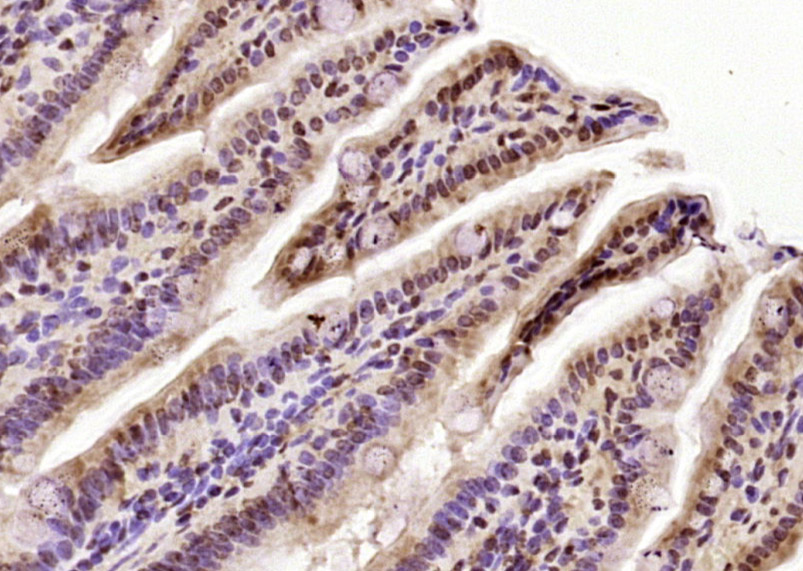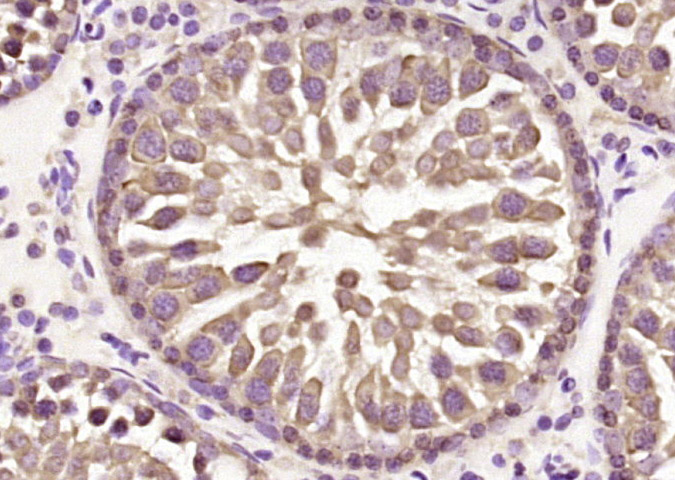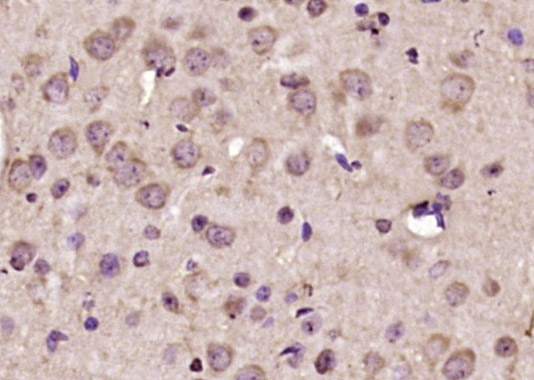
Rabbit Anti-HCF2 antibody
HC II; HCF2; HLS2; Leuserpin 2; LS2; Protease inhibitor leuserpin 2; SERPIND1; HEP2_HUMAN.
View History [Clear]
Details
Product Name HCF2 Chinese Name 肝素辅助因子II抗体 Alias HC II; HCF2; HLS2; Leuserpin 2; LS2; Protease inhibitor leuserpin 2; SERPIND1; HEP2_HUMAN. Research Area Cardiovascular Cell biology Immunogen Species Rabbit Clonality Polyclonal React Species Mouse, Rat, (predicted: Human, ) Applications WB=1:500-2000 ELISA=1:5000-10000 IHC-P=1:100-500 IHC-F=1:100-500 IF=1:50-200 (Paraffin sections need antigen repair)
not yet tested in other applications.
optimal dilutions/concentrations should be determined by the end user.Theoretical molecular weight 55kDa Cellular localization Secretory protein Form Liquid Concentration 1mg/ml immunogen KLH conjugated synthetic peptide derived from human HCF2/Heparin Cofactor II: 101-200/499 Lsotype IgG Purification affinity purified by Protein A Buffer Solution 0.01M TBS(pH7.4) with 1% BSA, 0.03% Proclin300 and 50% Glycerol. Storage Shipped at 4℃. Store at -20 °C for one year. Avoid repeated freeze/thaw cycles. Attention This product as supplied is intended for research use only, not for use in human, therapeutic or diagnostic applications. PubMed PubMed Product Detail The herpes simplex virus (HSV) infection is initiated by VP16, a viral transcription factor that activates the viral immediate-early (IE) genes.The anticoagulant action of heparin is dependent on plasma components termed heparin cofactors. The first of these to be well characterized was antithrombin III. Heparin Cofactor II is antigenically distinct from AT III. Heparin Cofactor II is normal in patients with AT III deficiency and is low in patients with disseminated intravascular coagulation. It is expressed predominantly in liver. Its function is: thrombin inhibitor activated by the glycosaminoglycans, heparin or dermatan sulfate. In the presence of the latter, Heparin Cofactor II becomes the predominant thrombin inhibitor in place of antithrombin III (AT III). Also inhibits chymotrypsin, but in a glycosaminoglycan independent manner and peptides at the N terminal of Heparin Cofactor II have chemotactic activity for both monocytes and neutrophils. The N terminal acidic repeat region mediates, in part, the glycosaminoglycan accelerated thrombin inhibition. Defects in SERPIND1 are the cause of Heparin Cofactor II deficiency. Heparin Cofactor II deficiency is an important risk factor for hereditary thrombophilia, a multifactorial trait characterized by recurrent thrombosis and abnormal platelet aggregation in response to various agents. Heparin Cofactor II deficiency is inherited as an autosomal dominant disorder, in which affected individuals are prone to develop serious spontaneous thrombosis.
Function:
Thrombin inhibitor activated by the glycosaminoglycans, heparin or dermatan sulfate. In the presence of the latter, HC-II becomes the predominant thrombin inhibitor in place of antithrombin III (AT-III). Also inhibits chymotrypsin, but in a glycosaminoglycan-independent manner.
Peptides at the N-terminal of HC-II have chemotactic activity for both monocytes and neutrophils.
Subcellular Location:
Secreted
Tissue Specificity:
Expressed predominantly in liver. Also present in plasma.
Post-translational modifications:
Phosphorylation sites are present in the extracellular medium.
DISEASE:
Defects in SERPIND1 are the cause of thrombophilia due to heparin cofactor 2 deficiency (THPH10) [MIM:612356]. A hemostatic disorder characterized by a tendency to recurrent thrombosis.
Similarity:
Belongs to the serpin family.
SWISS:
Q9Y5Z7
Gene ID:
29915
Database links:Entrez Gene: 29915 Human
Omim: 607926 Human
SwissProt: Q9Y5Z7 Human
Unigene: 506558 Human
Product Picture
Spleen (Mouse) Lysate at 40 ug
Primary: Anti- HCF2 (SL9843R) at 1/1000 dilution
Secondary: IRDye800CW Goat Anti-Rabbit IgG at 1/20000 dilution
Predicted band size: 52 kD
Observed band size: 52 kD
Paraformaldehyde-fixed, paraffin embedded (rat intestine); Antigen retrieval by boiling in sodium citrate buffer (pH6.0) for 15min; Block endogenous peroxidase by 3% hydrogen peroxide for 20 minutes; Blocking buffer (normal goat serum) at 37°C for 30min; Antibody incubation with (HCF2) Polyclonal Antibody, Unconjugated (SL9843R) at 1:200 overnight at 4°C, followed by operating according to SP Kit(Rabbit) (sp-0023) instructionsand DAB staining.Paraformaldehyde-fixed, paraffin embedded (rat testis); Antigen retrieval by boiling in sodium citrate buffer (pH6.0) for 15min; Block endogenous peroxidase by 3% hydrogen peroxide for 20 minutes; Blocking buffer (normal goat serum) at 37°C for 30min; Antibody incubation with (HCF2) Polyclonal Antibody, Unconjugated (SL9843R) at 1:200 overnight at 4°C, followed by operating according to SP Kit(Rabbit) (sp-0023) instructionsand DAB staining.Paraformaldehyde-fixed, paraffin embedded (mouse brain); Antigen retrieval by boiling in sodium citrate buffer (pH6.0) for 15min; Block endogenous peroxidase by 3% hydrogen peroxide for 20 minutes; Blocking buffer (normal goat serum) at 37°C for 30min; Antibody incubation with (HCF2) Polyclonal Antibody, Unconjugated (SL9843R) at 1:200 overnight at 4°C, followed by operating according to SP Kit(Rabbit) (sp-0023) instructionsand DAB staining.
Bought notes(bought amounts latest0)
No one bought this product
User Comment(Total0User Comment Num)
- No comment






 +86 571 56623320
+86 571 56623320
 +86 18668110335
+86 18668110335

